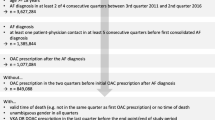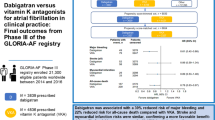Abstract
Atrial fibrillation (AF) is the most common arrhythmia in clinical practice and its prevalence increases with age. Few data are available about the clinical performance of direct oral anticoagulant (DOACs) in patients aged ≥ 80 years with AF. The aim of our propensity score matched cohort study was to compare the safety and efficacy of DOACs versus well-controlled VKA therapy among octogenarians with AF in real life setting. Data for this study were sourced from the multicenter prospectively maintained Atrial Fibrillation Research Database (NCT03760874), which includes all AF patients followed by the participating centers, through outpatient visits every 3 to 6 months. The database was queried for AF patients aged ≥ 80 years who received DOACs or VKAs treatment. The primary effectiveness endpoint was the occurrence of thromboembolic events (a composite of stroke, transient ischemic attack, systemic embolism); the primary safety endpoint was the occurrence of major bleeding; the secondary endpoint was all-cause mortality. The database query identified 774 AF patients aged ≥ 80 years treated with VKAs and 279 with DOACs. Propensity score (2:1) matching selected 252 DOAC and 504 VKA recipients. The mean follow-up was 31.07 ± 14.09 months. The incidence rate of thromboembolic events was 13.79 per 1000 person-years [14.80 in DOAC vs 13.34 in VKA group, Hazard Ratio 1.10; 95% confidence interval (CI) 0.49 to 2.45; P = 0.823]. The incidence rate of intracranial hemorrhage (ICH) was 8.06 per 1000 person-years (3.25 in DOAC vs 10.23 in VKA group, HR 0.33; 95% CI 0.07 to 1.45; P = 0.600). Through these incidence rates, we found a positive net clinical benefit (NCB) of DOACs over VKAs, equal to + 9.01. The incidence rate of all-cause mortality was 105.05 per 1000 person-years (74.67 in DOAC vs 118.67 in VKA group, Hazard Ratio 0.65; 95% CI 0.47 to 0.90; P = 0.010). The concomitant use of antiinflammatory drugs (HR 7.90; P < 0.001) were found to be independent predictor of major bleeding. Moreover, age (HR 1.17; P < 0.002) and chronic kidney disease (HR 0.34; P = 0.019) were found to be independently associated with thromboembolic events. In our study no significant difference in terms of both thromboembolic and major bleeding events, but a significant lower incidence of all-cause mortality, was detected in AF patients aged ≥ 80 years treated with DOACs vs VKAs.




Similar content being viewed by others
References
Go AS, Hylek EM, Phillips KA et al (2001) Prevalence of diagnosed atrial fibrillation in adults: national implications for rhythm management and stroke prevention: the AnTicoagulation and Risk Factors in Atrial Fibrillation (ATRIA) Study. JAMA 285(18):2370–2375
Lip GY, Nieuwlaat R, Pisters R, Lane DA, Crijns HJ (2010) Refining clinical risk stratification for predicting stroke and thromboembolism in atrial fibrillation using a novel risk factor-based approach: the euro heart survey on atrial fibrillation. Chest 137(2):263–272
Pisters R, Lane DA, Nieuwlaat R, de Vos CB, Crijns HJ, Lip GY (2010) A novel user-friendly score (HAS-BLED) to assess 1-year risk of major bleeding in patients with atrial fibrillation: the Euro Heart Survey. Chest 138(5):1093–1100
Chatap G, Giraud K, Vincent JP (2002) Atrial fibrillation in the elderly: facts and management. Drugs Aging 19(11):819–846
Kirchhof P, Benussi S, Kotecha D et al (2016) 2016 ESC Guidelines for the management of atrial fibrillation developed in collaboration with EACTS. Eur Heart J 37(38):2893–2962
Sardar P, Chatterjee S, Chaudhari S, Lip GY (2014) New oral anticoagulants in elderly adults: evidence from a meta-analysis of randomized trials. J Am Geriatr Soc 62(5):857–864
Verdecchia P, D'Onofrio A, Russo V et al (2019) Persistence on apixaban in atrial fibrillation patients: a retrospective multicentre study. J Cardiovasc Med 20(2):66–73
Russo V, Rago A, D'Onofrio A, Nigro G (2017) The clinical performance of dabigatran in the Italian real-life experience. J Cardiovasc Med 18(11):922–923
Russo V, Carbone A, Rago A, Golino P, Nigro G (2019) Direct oral anticoagulants in octogenarians with atrial fibrillation: it is never too late. J Cardiovasc Pharmacol 73(4):207–214
Singer DE, Chang Y, Fang MC et al (2009) The net clinical benefit of warfarin anticoagulation in atrial fibrillation. Ann Intern Med 151(5):297–305
Marinigh R, Lip GY, Fiotti N, Giansante C, Lane DA (2010) Age as a risk factor for stroke in atrial fibrillation patients: implications for thromboprophylaxis. J Am Coll Cardiol 56(11):827–837
Andreotti F, Rocca B, Husted S et al (2015) Antithrombotic therapy in the elderly: expert position paper of the European Society of Cardiology Working Group on Thrombosis. Eur Heart J 36(46):3238–3249
Russo V, Rago A, Proietti R et al (2017) Efficacy and safety of the target-specific oral anticoagulants for stroke prevention in atrial fibrillation: the real-life evidence. Ther Adv Drug Saf 8(2):67–75
Russo V, Bianchi V, Cavallaro C et al (2015) Efficacy and safety of dabigatran in a "real-life" population at high thromboembolic and hemorrhagic risk: data from MonaldiCare registry. Eur Rev Med Pharmacol Sci 19(20):3961–3967
Mant J, Hobbs FD, Fletcher K et al (2007) Warfarin versus aspirin for stroke prevention in an elderly community population with atrial fibrillation (the Birmingham Atrial Fibrillation Treatment of the Aged Study, BAFTA): a randomised controlled trial. Lancet 370(9586):493–503
Kooistra HA, Calf AH, Piersma-Wichers M et al (2016) Risk of bleeding and thrombosis in patients 70 years or older using vitamin K antagonists. JAMA Intern Med 176(8):1176–1183
Chugh SS, Havmoeller R, Narayanan K et al (2014) Worldwide epidemiology of atrial fibrillation: a Global Burden of Disease 2010 Study. Circulation 129(8):837–847
Patti G, Lucerna M, Pecen L et al (2017) Thromboembolic risk, bleeding outcomes and effect of different antithrombotic strategies in very elderly patients with atrial fibrillation: a sub-analysis from the PREFER in AF (PREvention oF Thromboembolic Events-European Registry in Atrial Fibrillation). J Am Heart Assoc 6(7):e005657
Patti G, Pecen L, Lucerna M et al (2019) Net Clinical benefit of non-vitamin K antagonist vs vitamin k antagonist anticoagulants in elderly patients with atrial fibrillation. Am J Med 132:749–757
Giustozzi M, Vedovati MC, Verso M et al (2019) Patients aged 90years or older with atrial fibrillation treated with oral anticoagulants: a multicentre observational study. Int J Cardiol 281:56–61
Ruiz Ortiz M, Muniz J, Rana Miguez P et al (2018) Inappropriate doses of direct oral anticoagulants in real-world clinical practice: prevalence and associated factors. A subanalysis of the FANTASIIA Registry. Europace 20(10):1577–1583
Sorensen R, Gislason G, Torp-Pedersen C et al (2013) Dabigatran use in Danish atrial fibrillation patients in 2011: a nationwide study. BMJ open 3(5):e002758
Howard M, Lipshutz A, Roess B et al (2017) Identification of risk factors for inappropriate and suboptimal initiation of direct oral anticoagulants. J Thromb Thrombolysis 43(2):149–156
Kwon CH, Kim M, Kim J, Nam GB, Choi KJ, Kim YH (2016) Real-world comparison of non-vitamin K antagonist oral anticoagulants and warfarin in Asian octogenarian patients with atrial fibrillation. J Geriatr Cardiol 13(7):566–572
Chao TF, Lip GYH, Chen SA (2019) Response by Chao et al to Letter Regarding Article, "Oral Anticoagulation in Very Elderly Patients With Atrial Fibrillation: A Nationwide Cohort Study". Circulation 139(1):146–147
Chao TF, Liu CJ, Lin YJ et al (2018) Oral anticoagulation in very elderly patients with atrial fibrillation: a nationwide cohort study. Circulation 138(1):37–47
Ruff CT, Giugliano RP, Braunwald E et al (2014) Comparison of the efficacy and safety of new oral anticoagulants with warfarin in patients with atrial fibrillation: a meta-analysis of randomised trials. Lancet 383(9921):955–962
Chai-Adisaksopha C, Crowther M, Isayama T, Lim W (2014) The impact of bleeding complications in patients receiving target-specific oral anticoagulants: a systematic review and meta-analysis. Blood 124(15):2450–2458
Amin A, Deitelzweig S, Jing Y et al (2014) Estimation of the impact of warfarin's time-in-therapeutic range on stroke and major bleeding rates and its influence on the medical cost avoidance associated with novel oral anticoagulant use-learnings from ARISTOTLE, ROCKET-AF, and RE-LY trials. J Thromb Thrombolysis 38(2):150–159
Lip GY (2015) Nonsteroidal anti-inflammatory drugs and bleeding risk in anticoagulated patients with atrial fibrillation. Expert Rev Cardiovasc Ther 13(9):963–965
Kent AP, Brueckmann M, Fraessdorf M et al (2018) Concomitant oral anticoagulant and nonsteroidal anti-inflammatory drug therapy in patients with atrial fibrillation. J Am Coll Cardiol 72(3):255–267
Olesen JB, Lip GY, Kamper AL et al (2012) Stroke and bleeding in atrial fibrillation with chronic kidney disease. N Engl J Med 367(7):625–635
Fanikos J, Burnett AE, Mahan CE, Dobesh PP (2017) Renal function considerations for stroke prevention in atrial fibrillation. Am J Med 130(9):1015–1023
Hart RG, Pearce LA, Asinger RW, Herzog CA (2011) Warfarin in atrial fibrillation patients with moderate chronic kidney disease. Clin J Am Soc Nephrol 6(11):2599–2604
Funding
No funding was received for this work.
Author information
Authors and Affiliations
Corresponding author
Ethics declarations
Conflict of interest
All authors declare no conflict of interest.
Ethical approval
The procedures performed in studies involving human participants were in accordance with the ethical standards of the institutional and/or national research committee and with the 1964 Helsinki declaration and its later amendments or comparable ethical standards.
Informed consent
Informed consent was obtained from all individual participants included in the study.
Additional information
Publisher's Note
Springer Nature remains neutral with regard to jurisdictional claims in published maps and institutional affiliations.
Rights and permissions
About this article
Cite this article
Russo, V., Attena, E., Di Maio, M. et al. Clinical profile of direct oral anticoagulants versus vitamin K anticoagulants in octogenarians with atrial fibrillation: a multicentre propensity score matched real-world cohort study. J Thromb Thrombolysis 49, 42–53 (2020). https://doi.org/10.1007/s11239-019-01923-9
Published:
Issue Date:
DOI: https://doi.org/10.1007/s11239-019-01923-9




